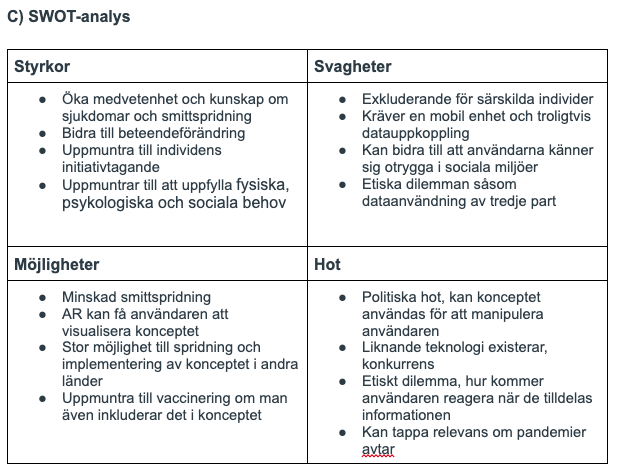Deliverables
- The Real: Investigating the real is about looking into the interests of society/people; it can be about media coverage, about researching what already exists as digital artefacts close the one you want to make, what limits in technology are there?
- At this point in the design process I decided to focus my work on only one concept, the Virus detector. The goal of the concept is to spread information and awareness about different kinds of pandemics and diseases, but also to make people feel more secure about their health and potentially be able to stop the spread of infection. My ambition with the concept is that they should be able to influence the intended target group's behavior, disseminate knowledge, and start discussions in relation to the human climate impact and the spread of infection.
- The users of the concept are in the age category 18-25 years, as the probability is higher that this younger generation is more familiar with AR and generally has a greater habit of using mobile-adapted services in their daily lives. Given the concept's ambition and goals, the intended user's generation is very suitable, as they show an increased degree of interest in how they themselves affect / experience the consequences of climate change today.
- Ethical Dilemmas: An ethical consideration that I as a designer tend to always keep in mind is accessibility. Which individuals will not be able to take part in my concept and why? At first, I put a lot of focus on pop ups with text, which is not available to many individuals on a small screen. After I changed my decision to read content, I also realize that sound will exclude some individuals as well. In my ethical considerations in accessibility, I always try to make decisions that will benefit as many individuals in society as possible.
- Dan saffer believes that we as designers have an obligation to ensure that the individual (user) remains respected, safe and dignified (Saffer, 2019). I immediately link this to the collection of data and how it is used for the benefit of the individual or not. How the concept's data collection will be used is beyond my control as a designer, but I can definitely imagine a scenario where the information about your illnesses is spread to, for example, insurance companies and not everything is kept in safe custody with the user.
- Regarding respect and dignity, it is also tolerable to criticize my concept because I as a designer will not be able to influence the reactions and behaviors that are followed by my concept. What is the interest of each individual in detecting diseases and infections around them and how will they treat people who are discovered to be ill? There is a possible scenario where my concept will be able to lead to harassment and attacks by sick people, which is not at all my ambition.
- These ethical dilemmas affect me indirectly as a designer because I do not have the power to determine the data collection policy, or how the user chooses to act when assigned the following information through my design. Just as Dan Saffer says in his article; “Every product is a set of decisions calcified. People then use those products to make their own decisions, for good or ill. ” (Saffer, 2019)
- SWOT: The SWOT-analysis is more economically and practically motivated. To answer the questions about the possibilities with, and threats to, my design, and the strengths and weaknesses it possesses, might help me to place my concept in relation to other existing designs. Please look at the imagine in the gallery above to see the result of the SWOT analysis.
- Referens: Saffer, D., 2019. Designing Ethically. [online] Medium.
- Next page - Research Part II

